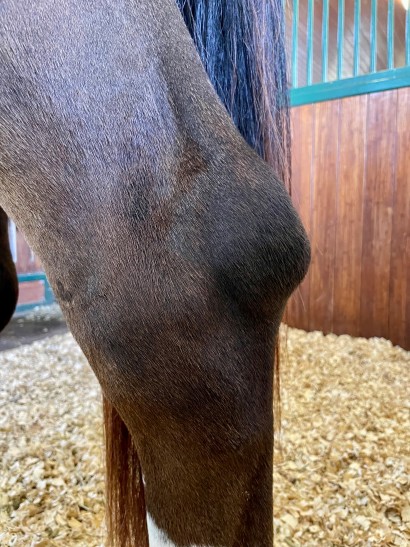Capped Hocks and Elbows in Horses
Updated December 15, 2023 | Reviewed By: Joan Maree Hinken, DVM, CVA, CVSMT

Capped hocks and elbows are swellings caused by trauma to two separate areas of a horse’s limbs. Capped hocks occur on the calcaneus (point of the hock), while capped elbows are on the olecranon tuberosity (point of the elbow).
These conditions are fairly common and look like a knob on the area. Capped elbows are also commonly referred to as shoe boils or elbow calluses.
Causes of Capped Hocks and Elbows
Trauma is the most common cause of both capped hocks and elbows. Capped hocks usually occur after a horse frequently kicks a stall wall or the back of a horse trailer. Capped elbows are typically caused by the hoof resting underneath the horse’s elbow when laying down and is usually a condition found in stabled horses. It can also be caused by an exaggerated motion resulting in the hoof hitting the elbow.
What’s Happening Beneath the Skin
The process of developing capped hocks or elbows involves a bursa forming under the skin. A bursa is a closed sac that has a membrane lining very similar to the synovial membrane found in joint capsules. They form when the skin travels over a bony prominence, such as the hock or elbow, and the connective tissue in the area tears. It fills with fluid until the body develops a fibrous capsule to contain the fluid. This is called an “acquired bursa” as the horse was not born with it.
Trauma to the area of the bursa will cause inflammation, called bursitis. In many cases, bursitis will be accompanied by pain and lameness. However, for capped hocks and elbows, very rarely is the horse in pain or lame, except when they initially happen.
Clinical Signs
There will be a localized swelling in the area with little associated heat. The amount of swelling and its thickness depend on the stage of the condition. In its early stages, a capped hock will be a softer swelling, while in later stages, it’ll be a more firm, fibrous enlargement.
Capped hocks and elbows do not cause lameness. If your horse with a capped hock and/or elbow and is lame, call your veterinarian as this could indicate a more severe condition.
Treatment for Capped Hocks and Elbows
For treatment to be successful, the area must be protected from further trauma.
To protect horse’s elbows, placing an elbow or shoe boil boot on the horse will help prevent further trauma to this area. These boots fit around the pastern of the affected limb and prevents the hoof from making contact with the elbow. Capped hocks are more difficult to prevent as it requires investigating the cause of the kicking and then trying to prevent the kicking from occurring.
Therapies for Reducing Swelling
Cold hosing and the application of topical DMSO and diclofenac (Surpass) may help decrease the fluid accumulation. Anti-inflammatories such as bute, flunixin, and firocoxib may help in decreasing the inflammation in early stages.
Veterinary Treatments
A veterinarian may inject a corticosteroid into the bursa and then apply a pressure wrap to keep fluid from accumulating. If the condition is refractory to the latter procedure, the vet may inject an iodine substance into the cavity hoping to encourage fibrosis of the area. At times an incision is made into the cavity and packed with iodine-soaked gauze.
These treatments are quite radical and, from the author’s experience, should be avoided as they usually result in complications and a more unsightly blemish. Often, these just become enlarged points that are blemishes and do not affect the soundness of the horse.
Horse Owner FAQs
Should you buy a horse with a capped hock?
If the horse is used for conformational purposes, such as showing in halter, a capped hock is a blemish and may be frowned upon by judges. However, capped hocks don’t normally cause lameness and don’t affect the horse’s motion so horses can still excel in disciplines like jumping, dressage, eventing, barrel racing, etc.
Can you ride a horse with a capped hock or elbow?
There is no reason to not ride a horse with a capped hock or elbow, but you may want to wait a short period of time (1-2 weeks) after the initial occurrence.